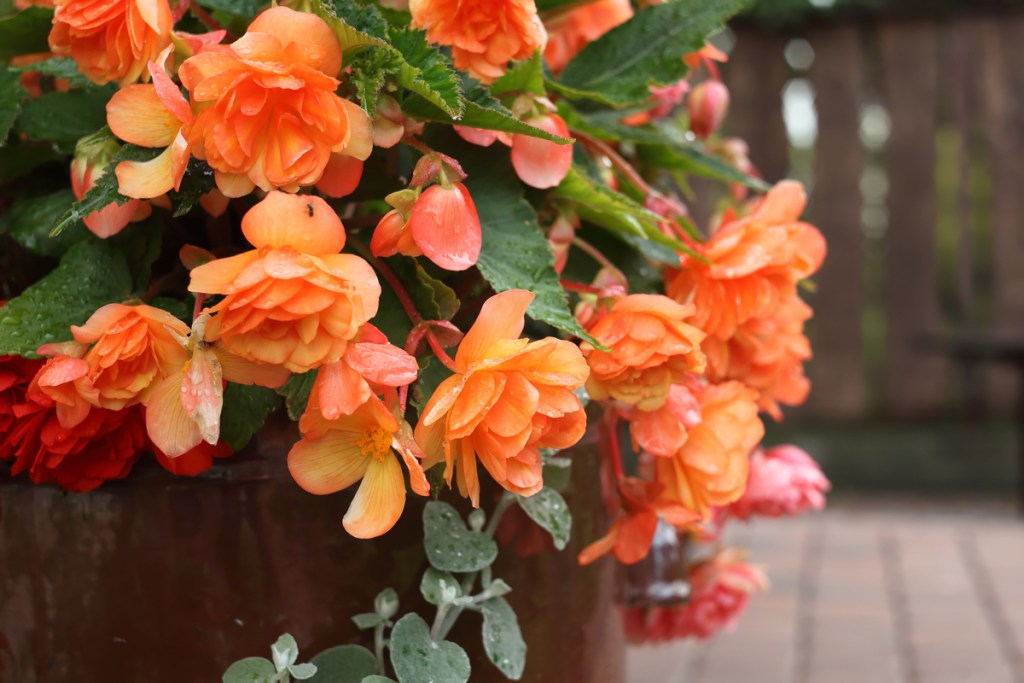Did you know begonias originated in a tropical climate? They thrive best in places with higher humidity, making their overall care a little bit different than that of a regular houseplant. If you live in a drier place, you may find yourself wanting a small humidifier to help the plant thrive. But what matters most is the basic care and space you give your begonia — and that starts with watering. Without the best care, you won’t get to enjoy the beautiful flowers that begonias offer as much as you wish.

How often should you water begonias?
If you’ve never had one before, you’re probably wondering, “How often should I water begonias?” Begonias have different watering needs depending on how old they are. Here's what to do:
Step 1: Keep the soil moderately moist for the first couple weeks as the begonia matures.
Step 2: Be careful not to overwater it. It’s always good to keep your plant in a pot that has good drainage, so when the water starts to come out at the bottom, you’ll have an indicator to stop watering.
Step 3: Test the soil to see how dry it is before watering mature begonias. If you stick your finger in and the soil is dry to your first knuckle, you’ll know that it’s time to water your begonia! This little trick will also help prevent you from overwatering the plant.
How do you water indoor begonias?
Luckily, the same rules for watering outdoor begonias work when you’re watering begonias indoors! In a pot with good drainage, wait to water the begonia until the top portion of the soil is dry and be wary of overwatering. Having a pot with good drainage will allow excess water to drain from the soil and prevent the plant from sitting in stagnant water.
Like other indoor plants, begonias enter a dormancy period in the colder months. During this time, you’ll want to water only once every three to four weeks to avoid similar situations with the plant drowning in water. Once growth begins in the spring, you can resume the regular watering schedule.

Do begonias prefer sun or shade?
The ideal condition for begonias is usually a mixture of partial sun and partial shade (typically morning sun and/or filtered lighting). Many windowsills or well-lit sun spaces in a home or apartment can accommodate this well; however, if you only have a form of indirect lighting, not to worry! Many begonias can withstand full shade/indirect lighting. They just won’t be as full as their counterparts grown in a mixture of light and will often have fewer flowers.
If you have an outdoor space, like a small patio or a garden, you can also place your indoor-grown begonias out there to absorb sunlight and bring them in as-needed if your windows don’t allow for proper conditions.
Keep in mind that it is possible for your begonia, like any other plant, to be in too much sun. Sun damage is often indicated by wilting, bleached/yellowing leaves, and stunted growth. If your begonia shows any of these signs, try moving it to a different location. The damaged parts of the plant can’t be fixed, but the begonia should be able to recover over time.
How to keep begonias blooming all summer long
One of the best ways to encourage blooming in begonias is to follow the proper watering and conditions tips as best you can. By providing your begonias with the best care possible, you’re most likely to see more blooms for a longer period of time. You can also fertilize your begonia once enough to ensure it has the proper nutrients needed for beautiful blooms.
There’s no guarantee that your begonia will bloom all summer long, but proper, diligent care is the best way to ensure that you have a happy, healthy plant!
Editors' Recommendations
- Everything you need to know about trailing succulents care for lush, thick growth
- How to pick the perfect orchid pots for healthy blooms
- Beyond basil and cilantro, add these unique plants to your indoor herb garden
- Your guide to rubber plant care and the best varieties to add to your home
- Easy hoya plants to add to your indoor plant collection


